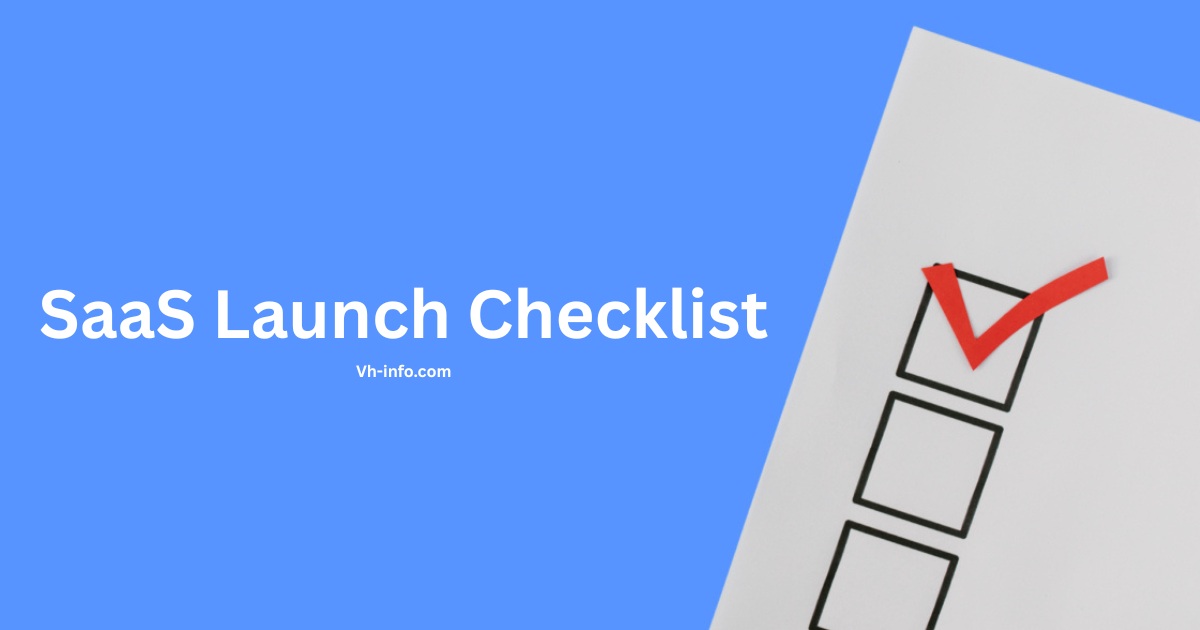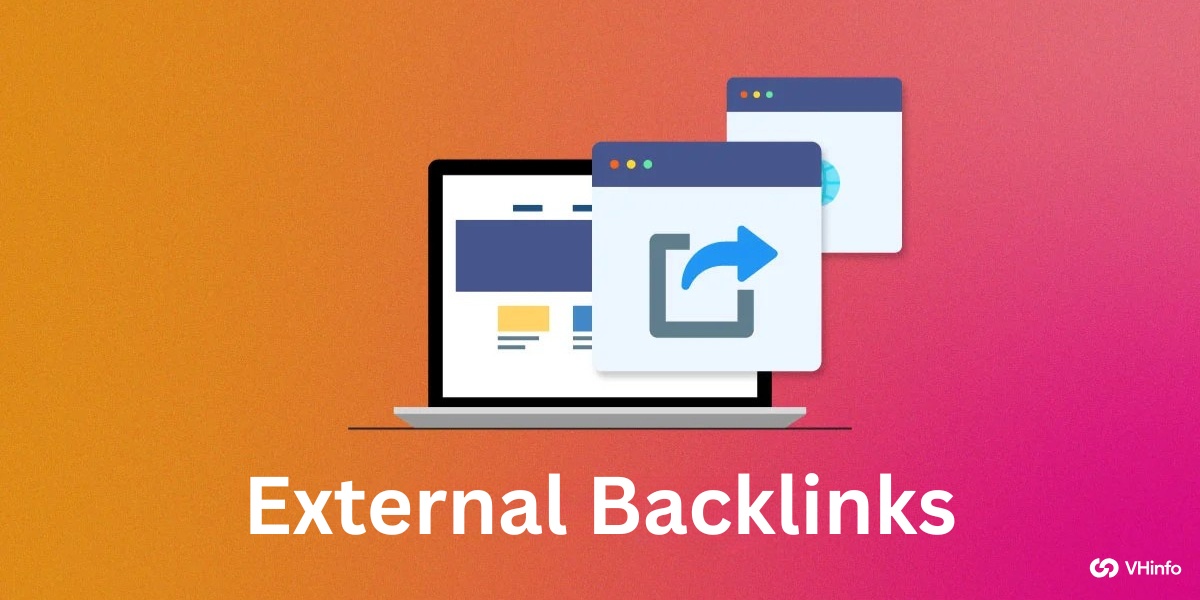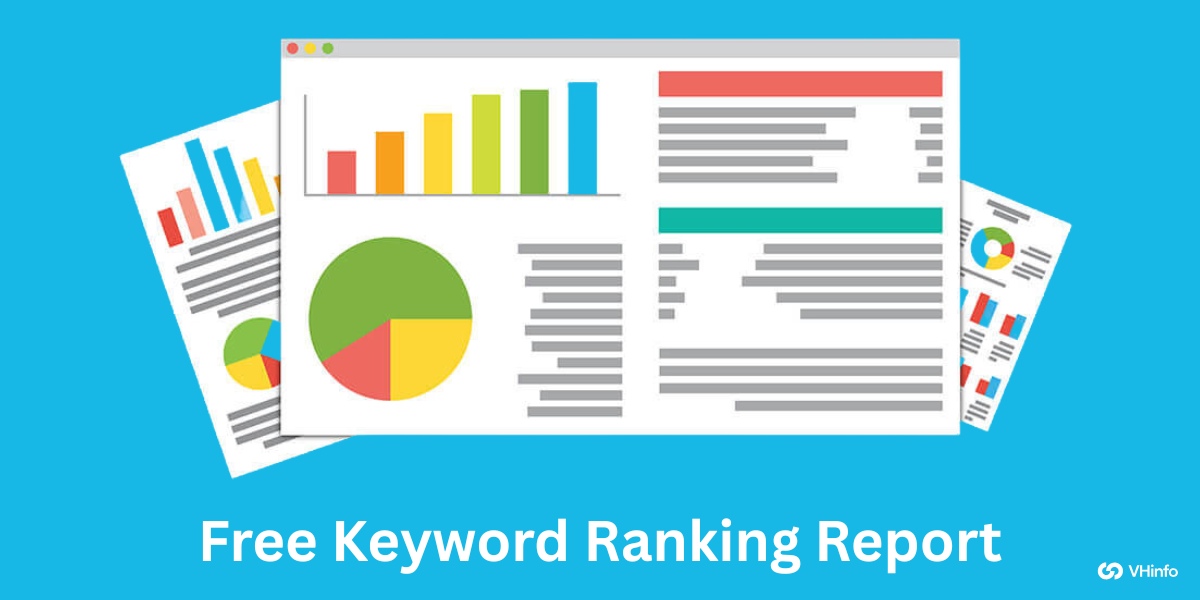Launching a new SaaS product? The process can feel overwhelming, but a clear roadmap turns chaos into confidence.
In today’s crowded SaaS landscape, a well-structured launch checklist isn’t just helpful; it’s essential. Without one, even the most innovative tools risk getting lost in the noise.
At VH-info, we’ve seen firsthand how a meticulous planning strategy helps SaaS businesses nail their product launch phase, connect with their target audience, and build momentum that lasts.
This guide breaks down the SaaS product launch into three actionable stages: pre-launch preparation, the launch day execution, and post-launch optimization.
You’ll learn how to validate your minimum viable product, create a unique selling proposition, and use user feedback to refine your offering.
Whether you’re fine-tuning marketing strategies or setting key performance indicators, this checklist ensures no critical step gets overlooked. Let’s turn your new SaaS product into a market-ready solution that solves real pain points and drives growth.
What Is A SaaS Product Launch?

A SaaS product launch is more than simply making your software available to users—it’s a strategic, coordinated process that begins long before your launch day and extends well beyond it.
It encompasses every activity required to introduce your software product to the market successfully.
A proper SaaS product launch involves preparing your infrastructure, marketing, legal compliance, and customer support. Success depends on aligning every aspect of your business to create an exceptional customer experience that drives adoption and retention.
Unlike traditional product launches, SaaS products don’t have a definitive endpoint.
After launch, your software must continuously evolve to meet changing user needs and market conditions. Think of your launch as the beginning of an ongoing relationship with your users rather than a one-time event.
Benefits Of Having A Launch Checklist

A well-structured SaaS product launch checklist provides numerous advantages that directly impact your success:
- Reduced Risk Of Critical Oversights: A comprehensive checklist ensures you don’t miss vital steps in your launch process.
- Improved Team Coordination: With clear responsibilities and timelines, your team can work cohesively toward launch objectives.
- Enhanced Market Positioning: Proper planning helps you create messaging that resonates with your target audience and differentiates your product.
- Maximized Return On Investment: By focusing resources on high-impact activities, you get better results from your launch budget.
- Faster Time To Market: A structured approach prevents delays and keeps your launch on schedule.
- Better User Experience: Planning for onboarding and support creates a positive first impression with new users.
- Clearer Performance Measurement: Predefined KPIs allow you to gauge success and make data-driven adjustments.
Key Challenges Without A Proper Launch Plan

Failing to implement a thorough launch plan creates significant obstacles to your SaaS product’s success:
- Poor Product-Market Fit: Without proper market research, your product may miss addressing real user needs.
- Weak Value Proposition: An unclear, unique selling proposition makes it difficult to convince potential customers to choose your solution.
- Technical Issues At Launch: Inadequate testing can lead to bugs and performance problems that damage user trust.
- Ineffective Marketing: Without a targeted strategy, your marketing efforts may fail to reach the right audience.
- Inadequate Onboarding: Poor user onboarding leads to confusion, frustration, and high churn rates.
- Pricing Problems: Incorrect pricing models can limit adoption or leave money on the table.
- Support Bottlenecks: Being unprepared for support requests creates negative customer experiences.
- Missed Growth Opportunities: Without proper planning, you may overlook key channels for user acquisition.
What Are The Stages Of A SaaS Product Launch?

A SaaS product launch has three key stages:
- Pre-Launch Phase: The pre-launch phase typically spans 3-6 months and focuses on research, preparation, and building your minimum viable product. During this critical period, you’ll conduct market research, define your unique selling proposition, develop your product, and create your go-to-market strategy. This phase lays the foundation for everything that follows.
- Product Launch Phase: The product launch phase usually lasts 1-2 months and centers on executing your launch plan. This includes announcing your product, engaging early adopters, ensuring smooth onboarding, and monitoring technical performance. The quality of your execution during this phase significantly impacts initial adoption and market perception.
- Post-Launch Phase: The post-launch phase extends 6-12 months beyond your initial release and focuses on refinement and growth. You’ll collect user feedback, iterate on your product, expand marketing efforts, and monitor key performance indicators. This phase transitions your focus from launching to scaling and sustaining your SaaS business.
SaaS Launch Checklist

Following a comprehensive checklist ensures your SaaS product launch addresses all critical elements for success. The following sections break down essential steps across each launch phase, providing a roadmap for your team to follow.
Pre-Launch Phase
- Step 1: Conduct Market Research – Start by digging into market trends and competitor strategies. Talk to potential users to uncover pain points your SaaS product can solve. Size up your market’s potential—this ensures you’re building something people need and will pay for.
- Step 2: Define Your Unique Selling Proposition (USP) – Ask: “Why should customers pick us?” Your USP should highlight what makes your product stand out—whether it’s faster workflows, smarter pricing, or features competitors lack. Test it with your target audience to ensure it sticks.
- Step 3: Build A Minimum Viable Product (MVP) – Focus on core features that solve the biggest problems. Skip the bells and whistles—your MVP just needs to work well enough for early adopters to test. Use their user feedback to improve before the full launch.
- Step 4: Validate Through Beta Testing – Recruit beta users who match your ideal customer profile. Watch how they interact with your product—where do they struggle? What do they love? Use these insights to tweak user experience and fix bugs early.
- Step 5: Create User Personas – Build detailed profiles of your ideal customers. Include their goals, challenges, and habits. These user personas will guide your marketing messages and ensure your product aligns with user needs.
- Step 6: Set Pricing and Launch Strategy – Research competitor pricing models and test options with your audience. Balance affordability with profit, and map out a go-to-market strategy—will you use social media, email campaigns, or partnerships? Set clear launch goals to track success.
- Step 7: Prepare Your Website, Marketing, and Sales Materials – Create a landing page that screams your USP. Develop a strong SaaS content strategy, and create blog posts, videos, and email templates that speak to your audience’s pain points. Consider creating a SaaS infographic to visually communicate your value. You may even work with a SaaS design agency to ensure your materials are professional. Don’t forget sales enablement tools like product demos and case studies.
- Step 8: Set Key Performance Indicators (KPIs) and Milestones – Choose 3-5 key performance indicators (like sign-ups or conversion rates) to measure progress. Understanding B2B SaaS funnel conversion benchmarks can help you set realistic targets. Break your launch timeline into smaller milestones—this keeps your team on track and highlights what’s working (or not).
Product Launch Phase
- Step 9: Execute Your Go-To-Market Strategy – Time to put your plan into motion! Roll out marketing campaigns across social media, email marketing, and content marketing, using SaaS newsletter examples for inspiration. Activate partnerships and hit “go” on paid ads if they’re part of your strategy, whether it’s PPC for SaaS in general, SaaS Facebook Ads, SaaS Instagram Ads, or LinkedIn Ads for SaaS. Engage niche communities—forums, Slack groups, LinkedIn—to spark early buzz. Consistency across channels amplifies your launch impact.
- Step 10: Announce Your Product Launch – Make some noise! Share your launch on Product Hunt, send press releases to industry blogs, and blast your email list with tailored announcements. Time your messaging for maximum visibility—think “big reveal” energy. This shapes how your target audience perceives your new SaaS product right out of the gate.
- Step 11: Engage Early Adopters – These first users are gold. Set up Slack channels or surveys to gather user feedback on features and customer experience. Fix issues fast, and reward them for referrals—discounts, swag, or shoutouts. Their success stories become your first case studies.
- Step 12: Provide User Onboarding – First impressions matter. Design a frictionless B2B SaaS onboarding process—think short tutorial videos or in-app pop-ups that highlight key features. Track where users get stuck, and tweak flows to reduce drop-offs. A smooth start boosts retention.
- Step 13: Watch Technical Performance – Don’t let bugs crash the party. Use tools like New Relic to monitor uptime and spot slowdowns during peak traffic. Have a “war room” ready to tackle emergencies. Quick fixes keep user trust high and complaints low.
- Step 14: Make Customer Support A Priority – Prep your team for incoming questions. Build a knowledge base with FAQs and how-to guides. Train support staff to resolve issues fast—slow responses frustrate new users. Turn support chats into customer feedback for future updates.
Post-Launch Phase
- Step 15: Gather User Feedback – Don’t stop listening post-launch. Use surveys, in-app prompts, and interviews to collect user feedback. Look for patterns—are users raving about specific product features or hitting the same roadblocks? Share insights with your team to align on fixes and updates. Close the loop by telling users how their input shaped changes.
- Step 16: Iterate Based On Insights – Turn feedback into action. Roll out regular updates that address pain points and add new features users want. Balance bug squashing with innovation—maybe that dashboard tweak matters more than a flashy AI tool.
- Step 17: Scale Marketing Efforts – Double down on what’s working. Convert happy customers into case studies or video testimonials. Experiment with new channels—maybe LinkedIn Ads or TikTok tutorials. Refine your messaging using real user behavior data.
- Step 18: Monitor Metrics and KPIs – Is your activation rate dropping? Are customer acquisition costs ballooning? Dig into your key performance indicators weekly. Use tools like Mixpanel to spot trends—maybe free trial users need better onboarding. Metrics like the Rule of 40 for SaaS can help you balance growth and profitability. Let data guide where to invest time and budget next.
- Step 19: Fuel Sustainable Growth – Explore untapped markets or niche segments. Partner with complementary tools to cross-promote by using effective SaaS partnership models. Add integrations that users keep requesting, like Slack or Zapier. Revisit your pricing model annually—does a tiered plan make sense now? Stay agile to keep growing without losing your core user base.
Essential Tools For SaaS Launches

The right tools streamline your launch process and improve outcomes across all phases.
Product Management Tools
Product management tools help coordinate development and launch activities:
- Project management platforms (Jira, Asana, Trello)
- Roadmapping tools (ProductPlan, Aha!)
- Documentation systems (Confluence, Notion)
- Wireframing and prototyping tools (Figma, InVision)
- Feature flagging systems (LaunchDarkly, Split)
These tools improve coordination and execution throughout your launch process.
Marketing Automation Tools
Marketing automation platforms enhance efficiency and effectiveness:
- Email marketing systems (Mailchimp, HubSpot)
- Social media management tools (Buffer, Hootsuite)
- Landing page builders (Unbounce, Instapage)
- Content management systems (WordPress, Webflow)
- CRM platforms (Salesforce, HubSpot CRM)
Automation tools help scale your marketing efforts without proportional resource increases.
Analytics and Tracking Platforms
Analytics tools provide important insights into performance:
- Web analytics (Google Analytics, Mixpanel)
- Product analytics (Amplitude, Pendo)
- Conversion optimization tools (Optimizely, VWO)
- Heat Mapping tools (Hotjar, Crazy Egg)
- Attribution platforms (AppsFlyer, Branch)
These platforms help you understand user behavior and marketing effectiveness.
Customer Feedback Systems
Feedback systems capture valuable user insights:
- Survey tools (SurveyMonkey, Typeform)
- In-app feedback widgets (Intercom, UserVoice)
- User testing platforms (UserTesting, Maze)
- Session recording tools (FullStory, LogRocket)
- NPS and CSAT measurement systems (Delighted, AskNicely)
Systematic feedback collection informs product development and marketing strategies.
FAQ’s:
How Long Does A Typical SaaS Product Launch Take?
A typical SaaS product launch takes 4-9 months from initial planning to post-launch stabilization. The pre-launch phase usually requires 3-6 months, the actual launch phase spans 1-2 months, and initial post-launch activities continue for 6-12 months.
Factors affecting the timeline include product complexity, team size, and market conditions.
What Are The Most Common SaaS Launch Mistakes?
Skipping market research tops the list—it leads to building something nobody needs.
An unclear value proposition leaves customers confused about why they should care.
Rushing through beta testing means launching with bugs that frustrate early adopters. Poor onboarding processes cause users to abandon ship quickly, while flawed pricing strategies either scare people off or leave money on the table.
Underestimating customer support needs and ignoring user feedback? Recipe for churn.
How Do I Know If My Product Is Ready To Launch?
Your MVP should solve core user pain points without major hiccups. If beta testing feedback is mostly positive and critical bugs are squashed, you’re close. Test your onboarding process—can users grasp the key features quickly?
Ensure customer support channels (help docs, live chat) are live and your team knows the launch goals.
Lastly, ask: “Does our messaging scream a unique selling proposition?” If yes, green light!
What Metrics Should I Prioritize During My SaaS Launch?
Track user acquisition (sign-ups, conversions) and activation rate—are people using core features? Measure time to value (how fast users see benefits) and retention rates (do they stick around?).
Net Promoter Score (NPS) reveals loyalty, while customer acquisition cost (CAC) keeps budgets in check. Watch feature adoption to see what’s resonating and monitor support ticket response times to spot UX gaps.
When Should I Start Preparing For My SaaS Launch?
Start preparing for your SaaS launch at least 3-6 months before your target launch date.
Early preparation allows sufficient time for market research, product development, beta testing, and marketing preparation. Begin with market validation even earlier to ensure you’re building something users actually want.
How Much Should I Budget For A SaaS Product Launch?
Your SaaS marketing budget should be carefully planned. Allocate 20-30% to product development (polishing features), 30-40% to marketing (ads, content), and 15-20% to sales enablement (demos, tools). Reserve 10-15% for customer support and 10% for surprises.
Startups might launch lean ($10k for basics), while established teams could spend $50k-$250k+ on full-scale launches. Always tie spending to KPIs like user acquisition or activation rate.
Conclusion
A successful SaaS product launch requires careful planning, strategic execution, and ongoing refinement.
The post-launch phase is equally important for gathering feedback, making improvements, and scaling your user base. Stay focused on providing value to your users, and continue to refine your product based on real-world usage and feedback.
At VH-info, we help SaaS companies build effective link building strategies that complement their product launches and drive sustainable growth. Understanding why is SEO important is the first step.
Our expertise in SaaS SEO, with services from a SaaS SEO consultant, and content marketing can help amplify your launch efforts and establish your product as a leader in your market segment. Our guide on Link Building For SEO can provide more details.
Ready to launch your SaaS product with confidence?
Start implementing this checklist today, and set yourself up for a successful product launch that leads to long-term growth and success.


